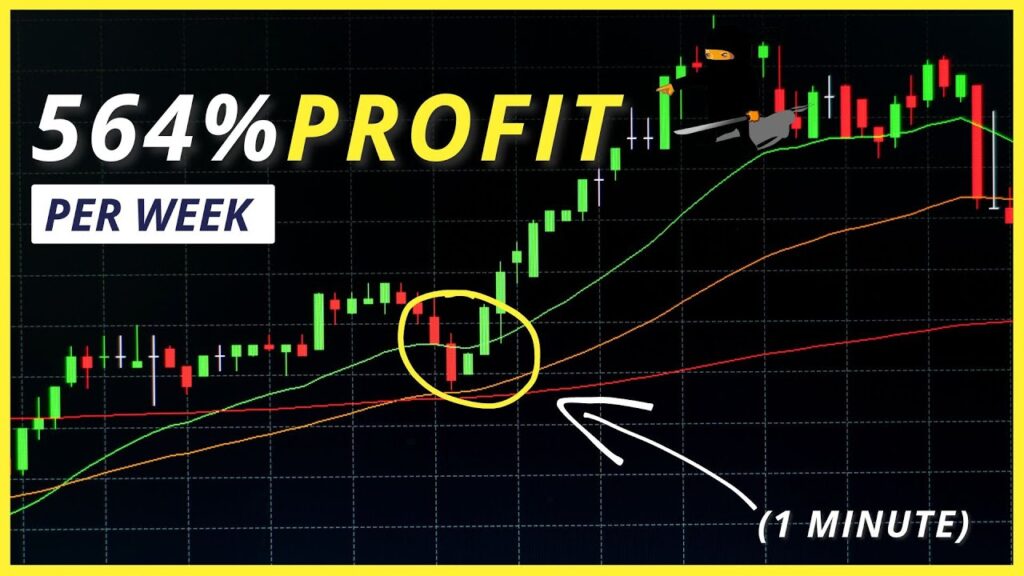In this video, I’ll be showing you a trading strategy that you can use to increase your profits from trading, and it’s very simple to use.
First of all, as you can see here on the chart, we have our chart setup.
One piece of advice to use with this strategy is that before entering a trade, it would do you well to look at higher time frames.
This is a momentum strategy, as you’ll see later in the video.
We are going to be trading using momentum, and it will be better if you check higher time frames.
For example, here, this is a Bitcoin US dollar one-hour chart, so you benefit by going to the four-hour or one-day chart and checking the momentum there before making your trades.
If you have strong upward momentum on the four-hour, you should be looking to make longs on your one-hour and vice versa.
Now let us look at the chart setup.
To first look at the chart setup, you need to understand the concept of support and resistance.
Support is a price point where the price bounces off and continues upwards.
Here, we can see a few examples of support at this level here, this level here, and this level here.
In order to get your support points, you can come to the tools and either use a horizontal array, which will give you a line like this, or a parallel channel, which will give you a channel like this.
Using those, you can find your specific support points, and these support points will be used to confirm our trade entries.
Now we’re going to also take a look at resistance.
Resistance is a point where the price bounces off and continues downwards.
As you can see, at this point, we have the price bouncing off and continuing down, bouncing off and continuing down, also at this point, at this point, and also around this area.
This now will be able to signal for sell positions.
One thing to note is that support and resistance are not necessarily prices; they are zones.
You’re better off looking at a certain zone rather than a very specific price.
Now for the indicator we’ll use, we’ll be using the Moving Average Convergence Divergence (MACD) indicator.
It is what is down here, but in order to insert it, you can come to indicators and search MACD.
There you have it; once you click on it, it will come up down here.
As I said earlier, this strategy is a momentum strategy, and that will be using momentum in order to make our trades.
The MACD indicator is a momentum indicator, and it shows whether we are bullish or bearish.
Now that we have understood what this indicator is and the chart setup, next we are going to look at how to get our trade entries.
In order to find our trading entries with this strategy, we are mainly going to be focusing on the MACD indicator to give us a signal, then looking at the support and resistance to further confirm our trade.
With the MACD, we have two lines, which are the signal line, which is this blue line, and the MACD line, which is the orange line.
For bullish momentum, meaning that the price is going upwards, we are going to want to see the signal line crossing above the MACD line.
For bearish momentum, which means that the price is going down, we are going to want to see the signal line crossing below the MACD line.
How do we use this to get our trading opportunities?
First, we need to take a look at a buy setup.
For a buy setup, we are going to want to be at a support zone, so either here, here, or here.
Next, we need to look for a buy signal from the MACD.
For a buy signal, we will not buy at this point, as this point is actually confirmed as a support, but we’ll look at this point as the price is bouncing off here.
As you can see here on the MACD, we do have the signal line crossing above the MACD line at this point, and as you can see, the price increases.
Let us take a look at another example.
We have a support point confirmed here, where the price bounces off several times.
At this point, this is the first bounce of this support, so we’ll not look at that, but we can look at this point where the price will bounce off again.
If you have momentum going up, meaning that the signal line is above the MACD line, as you can see here, then we can enter our trade at this support point, and the price goes up.
Another example is here.
This is the same support zone that we had previously looked at, and you can see the price bounces off here one more time.
At the same time, on the MACD, we can see that there is a cross of the signal line above the MACD line, and the price continues upwards.
Same as here as well.
Support point, the price bounces off, and we can see the signal line above the MACD line on the MACD indicator, and the price continues up.
Now that we’ve seen the entry signals for a buy position, we’re going to look at where we can most likely place our take profit or stop loss.
For a stop loss, we would put it either just below the support zone or at previous supports, so you can scan the chart and look for previous support zones or the previous swing low as well.
For here, we can put our support zone just a bit below this, and as for take profit, we can wait till the price hits another resistance zone.
For example, here, once you enter a trade here, we can put the price at this resistance point, where we think the price will bounce back and start coming downwards.
We can also use the MACD and see where we get our bearish signal.
We can ride this trade up until we see where the signal line crosses below the MACD line, which is here, and we can now take our profit.
That is the buy signal entry and how to trade it.
Next, we shall look at a sell signal entry and how to trade it.
Now we’ll take a look at a sell signal.
Just as for support, we need a resistance zone, so around here or here, as you can see marked on the chart.
Next, you need a sell signal on the MACD, in that the signal line crosses below the MACD line.
Let’s take an example of here, where we see a resistance has formed, and if we go to the MACD indicator, you can see the signal line, which is this blue line, has crossed below the MACD line.
We have bearish momentum, and as you can see, the trade goes our way.
Now we can also check here.
This one would be an example of one we wouldn’t take because, as you can see, at this point of hitting the resistance, the indicator still shows bullish momentum.
Here, we would not take this.
Remember, the signal line needs to be below the MACD line, but here it is still above the MACD line.
Let’s take another look at an example here.
We have this resistance point, and as you can see here, once the price hits resistance, the MACD becomes bearish as the signal line crosses below the MACD line.
Here as well, we do have a small cross, but the price becomes a bit more bullish once again and only crosses after you’ve hit the resistance, so we will not take that.
It is good for you to take note of the specific parameters needed in order to enter a trade.
As you can see, this trading strategy is very simple, and I hope it will be able to help you in your trading to increase your profits.
If you like the platform that I am using, it is called Bybit, and you can join the platform through the link below.
New users can get up to $30,000 dollars in deposit bonuses, so go ahead and click the link here to join Bybit.
They have a very big array of trading currencies as well as leverage trading and spot trading, which is what I’m using here.
It is a very good platform to use.
Go ahead and click the link above to join Bybit and start your trading.
If you enjoyed the video, don’t forget to like the video and subscribe to the page with notifications turned on so that you never miss another awesome trading strategy video.
By this, I am signing out.




